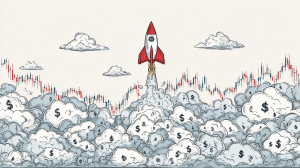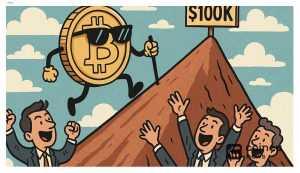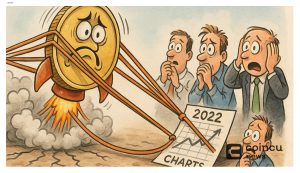Continuing in the series on the macro situation in the last half of 2022. If you haven’t read part 1, check it out here, in this part we will continue to build on the analysis in the previous section.
![[Part 2] Crypto Market Report For The First Half of 2022 1 Market Report](https://news.coincu.com/wp-content/uploads/2022/07/image-1161-1024x538.png)
Core Knowledge
- The US government implemented a tight monetary policy to withdraw excess money from the economy.
- Crypto markets are highly correlated with the US economy, fluctuating similarly to high-risk asset classes. So, when the US government implements a tight monetary policy, the crypto market tends to fall more sharply than other financial markets.
Monetary Policy From The Fed (Continue)
The Dot Plot chart in the Fed’s latest meeting at the June meeting has made this point clearer.
![[Part 2] Crypto Market Report For The First Half of 2022 2 the fed new dot plot](https://file.coin98.com/images/the-fed-new-dot-plot-ek9TPERCd5WhJtes.png)
Specifically, based on indicators and forecasts for inflation, GDP growth and unemployment, policymakers have set the Fed’s expected interest rate in 2022 to range from 3.1-3.9%. This number has increased 3-4 times compared to the end of 2021 and has negatively affected most financial markets (stocks, bonds, crypto…)
Regarding the plan to cut the balance sheet, according to Bloomberg, the Fed is expected to shrink its assets by about $ 5 trillion in the period from 2022 to 2026, of which:
- $600 billion in 2022.
- 1 trillion USD in 2023.
- 3 trillion USD in the period 2024-2026.
However, according to the Dot Plot chart above, the Fed is likely to loosen monetary policy again from 2024 onwards to stimulate the economy after the current difficult period. Therefore, it is possible that the shrinking $5 trillion target figure will not be realized.
On the other hand, the return to monetary easing accompanied by the Fed’s balance sheet not shrinking will be a more suitable environment for the growth of assets such as stocks, real estate, crypto …
Negative movements of asset classes
Under the impact of inflation, economic downturn and tight monetary policy from the Fed and central banks globally, different asset classes such as stocks, gold, bonds, and crypto… negatively affected.
As for the equity market, the S&P 500 index (representing the 500 largest companies by market capitalization on the US stock exchange) has recorded a decrease of ~21% since ATH and ~19.88% year-to-date. now.
In the difficult economic situation, cash flow was withdrawn, and interest rates increased, causing the costs of businesses to increase as well as revenue to decrease. This is the main reason for the stock’s current decline.
The bond market, which has always been considered a safe and low-risk asset class, also sold off under the negative impact of macro factors.
Yields on 10-year US government bonds continue to maintain an uptrend, showing that bond selling pressure is taking place under the impact of interest rate hikes and the Fed’s bond selling activities to narrow. Accounting balance sheet.
In contrast to stocks, the real estate market is still remaining high (for house prices) as a result of the previous low-interest rate environment. The US home price index, although growth has slowed down, is still at a high level. Even the growth rate in 2021 is greater than the pre-bubble period in 2004.
![[Part 2] Crypto Market Report For The First Half of 2022 3 house prices at high altitude](https://file.coin98.com/images/house-prices-at-high-altitude-MpJ73jV7kaS93JqY.png)
Besides the US, many countries such as New Zealand, Canada, and Australia … are also being warned by OECA at a high level.
![[Part 2] Crypto Market Report For The First Half of 2022 4 new zealand at top of risk ranking](https://file.coin98.com/images/new-zealand-at-top-of-risk-ranking-EYRVFp3uOWtmAJMi.png)
The housing market is always at risk as debt and liquidity problems pose a risk to the economy. In fact, there are still countries where the real estate situation is very hot.
Rising house prices also have a direct impact on people’s income and savings as they have to bear higher costs of accommodation.
Gold price movements in 2022 were highlighted in the event of political conflict between Russia and Ukraine with an increase of 13.6% within 1 month from the beginning of February to March.
![[Part 2] Crypto Market Report For The First Half of 2022 5 Gold Price](https://news.coincu.com/wp-content/uploads/2022/07/image-914-1024x702.png)
However, after that, the gold price cooled down again due to the effects of tight monetary policy, since the beginning of the year until now, gold has almost no change in price, only increasing by 0.2%.
Thus, when looking at the macro factors, it can be seen that when the economy goes down, people’s income and savings decline, and financial assets can hardly grow. Although there are still some asset classes that have increased in prices such as real estate or commodities and food, they are not positive factors and also pose certain risks to the economy.
In that context, assets that are considered high risk like crypto have lost interest from investors. Moreover, the downward economic situation plus rising costs also affect the major crypto institutions in the market, thereby causing negative effects such as staff layoffs, lack of liquidity, burden due to lack of liquidity, etc. use of leverage, … increased, causing many organizations to go to the brink of bankruptcy.
Summary of macroeconomic & political situation in the first half of 2022:
- The war between Russia and Ukraine took place as a major event affecting the economy, making people’s lives difficult, and the cost of basic goods increased, causing savings and investment to decline.
- The Fed and central banks globally implemented quantitative tightening leading to less abundant liquidity in the market.
- In that context, financial assets such as stocks, bonds, gold, etc. are negatively affected. Although the real estate market is still in an uptrend, this growth is potentially risky for the economy.
In summary, it seems that investors in the market have “priced in” based on the macro variables analyzed above, but there are still many risks ahead, requiring defensive moves in the portfolio. investment in this period must continue to be appreciated.
Verdict
In the next part (Part 3) we will dive deeper into the Crypto market and how macroeconomic policy impacts affect this market.
If you have any questions, comments, suggestions, or ideas about the project, please email ventures@coincu.com.
DISCLAIMER: The Information on this website is provided as general market commentary and does not constitute investment advice. We encourage you to do your research before investing.
Join CoinCu Telegram to keep track of news: https://t.me/coincunews
Follow CoinCu Youtube Channel | Follow CoinCu Facebook page
Marcus
Coincu Venture






















